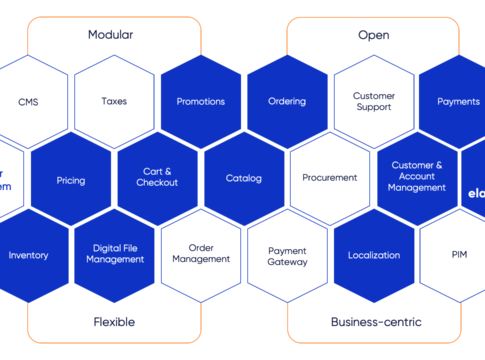Elastic Path, the leading headless commerce microservices solution for high-velocity brands, today announced it has spearheaded “Composable Commerce™”, an approach which codifies the best practices associated with an industry movement towards modular, interoperable services used to design cohesive digital architectures that drive growth for progressive businesses.
Composable Commerce was born out of a necessity to overcome the rigid nature of legacy eCommerce “platforms”, which were designed to solve yesterday’s eCommerce business models, and not today’s realities of operating a high-growth eCommerce business where customers are hyper-connected, and B2B companies are blurring the lines between B2C and B2B with unique and hybrid models.
“We have a complex and dynamic business, so embracing Composable Commerce will be key to our ability to achieve our digital commerce vision in a way that enables us to move fast, support our unique business requirements, and delight our customers and partners.” Rebecca Hicks, Senior Manager Digital Experience, Pella Corporation
Composable Commerce™ comes from the concept of composability, a systems design principle where “components can be selected and assembled (i.e. composed) in various combinations to satisfy specific user requirements.” Contrary to the rigid, closed architectural approaches that have dominated the market for years, there are four key tenets that define the Composable Commerce approach:
- Modular: Designed to be fully modular, meaning that each component is a self-contained system that can be deployed independently.
- Open: Based on open standards, integration patterns, and extensibility models that encourage interoperability and customization of both third-party and proprietary API services designed by technology vendors, the business themselves, or their solution and integration partners.
- Flexible: Leverage modern, flexible technologies and approaches, such as microservices, APIs, cloud, and headless (i.e. MACH) and JAMstack (JavaScript, APIs, & Markup language) architectures.
- Business-centric: Inclusive of all necessary tools and capabilities for business teams to have full control to “compose” disparate services into an end-to-end solution that addresses complex and dynamic business requirements, enables rapid iteration to respond to changing business requirements, and lowers the cost and risk of innovation.
“As more B2B businesses embrace eCommerce, and as the lines between traditional B2B and B2C business models become increasingly blurred, organizations need to rethink their tech stack. Flexibility and agility are key. I have seen some of the more traditional, rigid “platform” approaches struggle to adapt to the unique eCommerce requirements of B2B organizations. The Composable Commerce approach holds the promise of allowing brands to gain greater control over how they deliver eCommerce initiatives with complex requirements and multiple routes to market, and do so in an agile manner.” – Brian Beck, Author, “Billion Dollar B2B Ecommerce” and Managing Partner, Enceiba
The emergence of modern technologies such as microservices, APIs, cloud, headless, and JAMstack offer tremendous benefits, but are just one dimension of a best-of-breed eCommerce technology stack. Composable Commerce provides brands and retailers with an approach for how to leverage these technologies as part of a broader architectural strategy designed to address the full scope of business and technology requirements necessary to unlock eCommerce business growth. Organizations that leverage a Composable Commerce approach are able to reap tremendous benefits, including:
- Business Benefits:
- Monetize any customer touchpoint (e.g. web, mobile, in-store, IoT, AR/VR, and more)
- Deliver highly differentiated commerce experiences to stand-out from competitors
- Enable commerce experiences with complex business requirements, in a way that is tailored to each business’s unique requirements with pin-point control and precision
- Technology and Operational Benefits:
- Eliminate vendor lock-in risk by swapping in/out components on-demand over time as business needs evolve
- Rapidly respond to changing business requirements with architectures designed for iteration
- Leverage modern technology standards to reduce costs and increase operational efficiencies (e.g. systems management, staffing, etc)
“As pioneers of headless commerce back in 2011, we embarked on a mission to help the market overcome the inflexibility of monolithic solutions. Over the years, as new concepts such as Omni-Channel and Unified Commerce emerged, Elastic Path has been there to support new innovative models and applications. As a continued evolution and refinement of these concepts, we are thrilled to spearhead Composable Commerce as the next step on this journey by providing an approach for enabling companies to fully leverage composable services and capabilities to unlock significant commerce innovation, creativity, and adaptable business models.” Sal Visca, Chief Technology Officer, Elastic Path.





